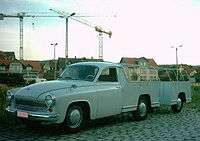Wartburg 311
| Wartburg 311 | |
|---|---|
_02.jpg) Wartburg 311 Limousine | |
| Overview | |
| Manufacturer | VEB Automobilwerk Eisenach |
| Production |
1956 – 1965 288,535 produced [1] |
| Assembly | VEB Automobilwerk Eisenach, Eisenach, East Germany |
| Designer | Hans Fleischer |
| Body and chassis | |
| Body style |
4-door sedan 3-door estate 5-door estate 2-door pickup truck 2-door coupe 2-door roadster |
| Layout | FF layout |
| Related | Wartburg 312 |
| Powertrain | |
| Engine | 900cc 3-cylinder two-stroke in line engine |
| Transmission |
3-speed manual (1956-1957) 4-speed manual (1958-1965) |
| Dimensions | |
| Wheelbase | 2,450 mm (96.5 in) |
| Length | 4,300 mm (169.3 in) |
| Width | 1,570 mm (61.8 in) |
| Height | 1,450 mm (57.1 in) |
| Curb weight | 960 kg (2,116 lb) |
| Chronology | |
| Successor | Wartburg 353 |
The Wartburg 311 was a car produced by East German car manufacturer VEB Automobilwerk Eisenach from 1956 to 1965. The 311 model was manufactured in a number of variations, including pickup, sedan, limousine, coupe, and as a two-seater roadster. The engine was enlarged to 992cc in 1962.
Background
Production of the Wartburg 311 was already underway at Eisenach by the end of 1955. The car was a development of the existing EMW 309. This was the car previously identified as the IFA F9, which itself had been based on the 1940 DKW F9 scheduled for launch in 1940 until war intervened.
The car
The basic architecture of the design forcibly acquired from Zwickau based Auto Union used a chassis lengthened by 10 cm which combined with long overhangs to create a larger car, with a relatively spacious four door sedan/saloon body.
The name "Wartburg" came from the very first model produced at the Automobilwerk Eisenach factory, back in 1898, three decades before that company had been acquired by BMW, and nearly five decades before the plant's location in the Soviet occupation zone placed it under state control. The "311" designation followed the tradition of the plant's previous owner, BMW, whose Eisenach produced passenger cars had all been identified by a three digit number starting with a "3".
The use of a separate chassis facilitated the adaptation of the car to a range of differing body shapes. On the other hand, the use of a separate chassis with the frame rails running under the passenger compartment's floor during a period when automakers elsewhere in Europe were increasingly standardizing on self-supporting car bodies, left the Wartburg approach looking increasingly dated - and also added to the car's height, while "low-long-sleek" was becoming the order of the day in car styling.
Export markets
Exports of the Wartburg 311 to West Germany started in 1958, and by the early 1960s the car was exported to many other countries, including the United Kingdom and United States.
Argentinian production
Previously the 311 model, in Argentina the sedán Justicialista change the name to Graciela in 1956 and have a 3-cylinder (2-stroke) Wartburg engine until 1961.[2] Since 1962, are replaced with the Graciela W, a Wartburg 311 - only with the 4-door body – with the same engine and made by DINFIA in Córdoba.[3] Just 646 made in two years (1962 until 1964).
Replacement
The 311 model was replaced with the Wartburg 353 in 1966, because its rounded design was becoming outdated, therefore a more boxy design was adopted, however the mechanical part and the chassis and the rest of underpinnings were much about the same. There was also a model between them, the Wartburg 312 (September 1965 - March 1967), which was a modified version of the 311 with some parts of the Wartburg 353. Some Wartburg 312 models were equipped with the 50 HP engine that could be lately found on earlier Wartburg 353 series, and also some were equipped with disc brakes at the front. Some enthusiasts replaced the body of a 312 with the body of a 353 on the same chassis, without major modifications.
Variants
Wartburg 311
- 311/0 Standard Limousine (4-door sedan)
- 311/1 Luxus-Limousine (4-door luxury sedan)
- 311/2 Cabriolet 2-door (since March 1956)
- 311/3 Coupé 2-door
- 311/4 Kübelwagen (Police off-road), only 891 were produced (1959 - 1964)
- 311/5 Camping-Limousine (5-door station wagon)
- 311/6 Limousine (RHD 4-door sedan)
- 311/7 pickup 2-door (since March 1956)
- 311/8 Schiebedach-Limousine (4-door sedan, with sunroof)
- 311/108 Luxus-Limousine mit Schiebedach (4-door luxury sedan, with sunroof)
- 311/9 Kombi (station wagon) 3-door (since March 1956)
- 311-300 Hardtop Coupé (HT) 2-door
- 313/1 Sportwagen (2-door roadster / since the spring of 1957, with 50 hp)
 Wartburg 311/3 Coupé
Wartburg 311/3 Coupé Wartburg 311/5 Camping Limousine
Wartburg 311/5 Camping Limousine Wartburg 311/7 pickup
Wartburg 311/7 pickup- Wartburg 311/9 Kombi
 Wartburg 313/1 Sportwagen
Wartburg 313/1 Sportwagen
Wartburg 312
- 312/0 Standard Limousine (4-door sedan)
- 312/1 Luxus-Limousine (4-door sedan)
- 312/5 Camping-Limousine (5-door station wagon)
- 312-300 Hardtop-Coupé (HT) 2-door
- 312 Pick-up truck. It is unknown whether they were made by the factory or were manufactured by some owners. However, the later 353 was available as pickup truck.
External links
| Wikimedia Commons has media related to Wartburg 311. |
References
- ↑ Personen-kraftwagen sozialistischer länder, Dünnebier. Kittler ISBN 3-344-00382-8
- ↑ http://www.cocheargentino.com.ar/j/justicialista.htm#graciela
- ↑ http://www.cocheargentino.com.ar/j/justicialista.htm#gracielaw